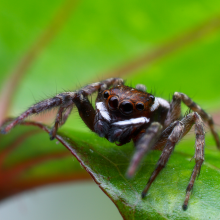We find out if we could mix spider and human DNA to create a real life Spiderman. Plus we ask, do foetuses get cancer?
In this episode

00:00 - Can we mix human and spider DNA?
Can we mix human and spider DNA?
Hannah Critchlow untangled this sticky question...
Hannah - This week we wonder if we can make a real life Spiderman, and Enriques got in touch with this question...
Enriques - If we put the DNA from a spider into a human what would happen.
Hannah - So can you successfully mix spider and human DNA and what could you create. If so we turn to a genetics professor working where Dolly the sheep was created.
Helen - Hello my name is Helen Sang; I work at the Roslin Institute which is part of the University of Edinburgh. It would be relatively easy to introduce spider genes into humans by adapting the methods we used to make genetically modified mice, for example, and combining this with the techniques used in in vitro fertilization - IVF - that are used to make test tube babies. We can introduce genes into specific tissues or organs; this is the basis of gene therapy. This is very new technology and it's only just becoming licensed as a medical treatment. And here we would introduce a gene into a specific tissue, for example muscle, and repair a mutation.
Hannah - So it is possible to mix the DNA of humans and spiders. For this scenario, let's ignore the strict regulations in place to ensure these methods are used responsibly, and ask instead could we actually make a real life Spiderman?
Helen - Spiderman had a lot of characteristics of a superhuman that he was hyperactive and an elite athlete: many characteristics that individuals have some of, but nobody has all these different characteristics. We have people who are sprinters, or people who are very energetic, but Spider man pulls a lot of these characteristics together and at the moment human geneticists are identifying variations in our genes that lead to these differences. So maybe Spiderman has just got the elite versions of many of these genes. We could think about, in the longer term, genetically modifying people so that they could sprint and were very active and very intelligent, but that would require us to make a lot of changes by genetic modification. And not only is that illegal but I think that's a bit too much of a challenge for today...
Hannah - And researchers have genetically tweaked a goat to produce spider silk protein in its milk. So maybe we could purify this goat's milk to produce a Spiderman Web shooter. Joseph Katz added via Facebook: "the trait that allows spiders to climb walls has a lot to do with their low mass to surface area ratio. Dense humans might be better off taking inspiration from geckos, whose wall-sticking ability is due to millions of microscopic Velcro-like hair pads on their feet. Now, sticking with the genre of genetics, we glide into this question:
Louis - Hi my name's Louis. I'm 15 and I come from London. I was just wondering. In foetuses, the cells multiply really quickly; but I've never heard of one having cancer. Is it possible?
Hannah - So can fetuses become cancerous? What do think about that one? Let us know by posting on the Naked scientist's Facebook page. You can e-mail Chris at the naked scientist dot com. You can join in the debate live on our forum which is that Naked Scientist stock com slash forum or you can tweet at Naked Scientists.
Related Content
- Previous A Short History of the Oceans
- Next Icy Life and Slimy Fibres










Comments
Add a comment